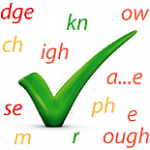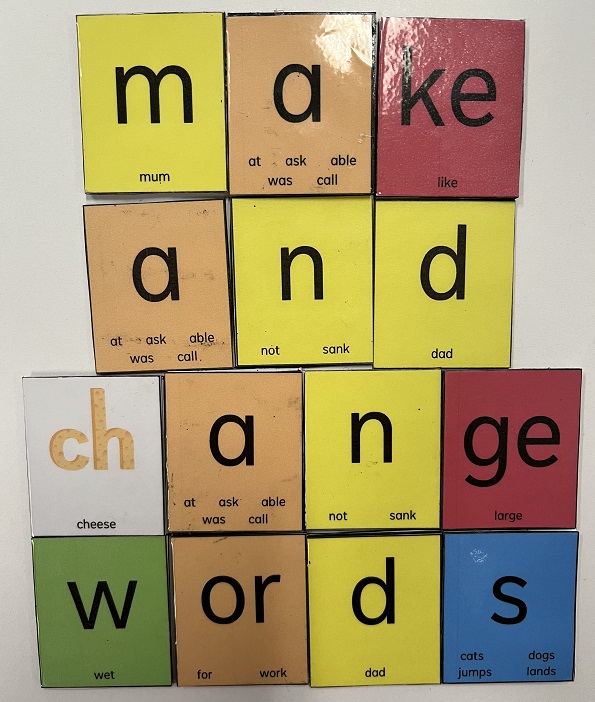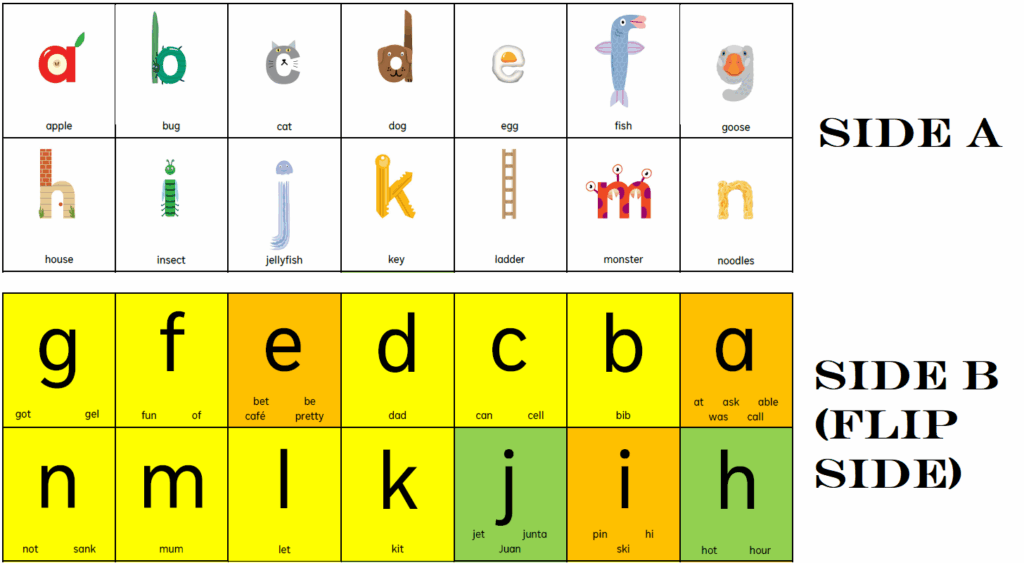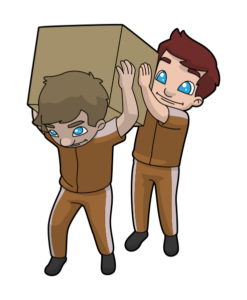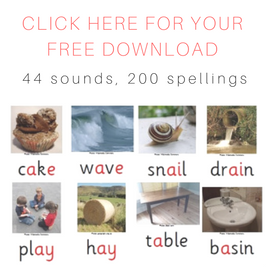New moveable alphabet with embedded picture mnemonics, and free sound swaps
The download-and-print Spelfabet moveable alphabet and affixes now has embedded picture mnemonic tiles, and is useful for showing learners how to take words apart into sounds (phonemes), spelling patterns (graphemes) and meaningful parts (morphemes), manipulate their parts, and learn how all these parts are related.
This is the alphabet I use in my presentation for today’s free Sounds-Write symposium, hope you enjoy it.
There’s now a new n/noodles mnemonic that looks like Asian noodles (not pasta!). There are versions for Aussie, UK/formal Australian and US speakers e.g. with e/echo and o/octopus for US English, and k/kangaroo for rural Aussie kids who know more about wildlife than keys.
Just over half the tiles are designed to be double-sided so they can be flipped to show spelling variations. The set comes with 55 A4 pages of sound swaps/word chains to make, the first set of which can be downloaded free here, so you can check/try them out. Inflectional morphemes plus suffix -y (boss-bossy) and agent noun -er (swim-swimmer) are introduced early in the sound swaps.
There are embedded picture mnemonics for each phoneme except the unstressed vowel and the /zh/ in beige, vision and treasure, not needed for early word-building. These help beginners remember sound-letter relationships. As a sound for each letter is learnt, its tile is flipped over to show just the letter and (an) example word(s) illustrating how it is pronounced (but kids can and do flip it back if they forget):
The mnemonics for additional sounds are great for making it clear that our language has more sounds than letters, e.g. these consonant sounds don’t have their own letters:
Extra mnemonics for vowels also make it clear that some spellings represent more than one sound, for example:

Learners need to know that letters which follow a vowel often show us how to say it e.g. ‘back‘ versus ‘bake‘. Instead of ‘split’ vowel spellings, the set now has extra red consonant-e spellings, and the extended code sound swaps include switching between ‘short’ and ‘long’ vowels by changing word-final spellings. There are still single consonant tiles with doubled consonants on the flip side e.g ‘t’ with ‘tt’ on the flip side, making it easy to show that ‘cut’ gains an extra ‘t’ letter (but not an extra sound) when a vowel suffix makes it into ‘cutter’ (not ‘cuter’, which is formed by building c+u+te and then knocking off the ‘e’ with the vowel suffix, making relevant ‘kapow’ noises).
The same traffic-light based colour coding (green = start/word beginnings, orange = caution, red = stop/word endings) for graphemes. Yellow spellings are used either side of a vowel. The set has pink prefixes and blue suffixes, and includes all the high-utility affixes in this Lane et al (2019) research. There are little chameleons on assimilated prefixes, to show that their last sound and/or letter often changes to better match what follows (e.g. in + mature = immature, con + relate = correlate). Colour coding lets you help kids narrow down their visual search for a tile, as you can say e.g. ‘use a red one’ or ‘use an orange one’.
There are now twelve pages of tiles to print, grouped from basic to advanced, so they can be assembled in stages, and you don’t get scissor-and-glue-gun RSI. If you don’t need magnetic tiles for a whiteboard, just print the first eight pages double-sided, the rest single-sided, laminate and cut them up for use on a tabletop. Easy peasy. Otherwise, assemble them with magnets (instructions are included) and display them in groups on a whiteboard like this, with duplicate tiles stacked to reduce visual clutter:

Only download and print the version most suitable for the English your learners speak, but if you want to mix and match them or use a mnemonic from an earlier set (e.g. if you prefer g/girl to g/goose or y/yoga to y/yawn), you can get the picture files and print your own extra tiles. If you want a version created for the English you speak (NZ? Canada? India? elsewhere?), let me know what it is and what you suggest adding/changing/removing.
A while ago I was working with a student with a flair for chemistry who called this product ‘the periodic table of spelling’. I hope you agree that it now demonstrates all the main elements (spellements?).
P.S I’m still updating the other embedded picture mnemonic products with the new ‘n/noodles’, and we’ll shortly be releasing new Syl-lab-it card games targeting polysyllable words, cleverly designed by our gamification (5 syllables, is that a Thing?) whiz, Elle Holloway, and often requested by kids we see. Stay tuned!
Alison Clarke
PS2 The Spelfabet Embedded Picture Mnemonic pictures are drawn by and © Cat MacInnes.
Diphthongs

Why do kids often count an extra syllable in words like ‘nightingale’, ‘crocodile’, ‘pigeonhole’, ‘waterfowl’, ‘hydrofoil’, ‘silverware’ and ‘puppeteer’?
Some vowel sounds shift from one place in the mouth to another, including the final vowels in the above words. They’re called diphthongs (pronounced ‘diff-thong’, from the Greek prefix di meaning “two” and phthongos meaning “sound, voice”*). When you say words containing diphthongs slowly and think about what your mouth is doing, it’s easy to understand why they’re sometimes counted as two vowels.
Australian English diphthongs are /ae/ as in ‘day’, /ie/ as in ‘my’, /oe/ as in ‘no’, /ou/ as in ‘out’, /oi/ as in ‘boy’, /air/ as in ‘care’ and /ear/ as in ‘dear’. To most Americans** and others who pronounce word-final /r/ (have a rhotic accent), /air/ and /ear/ aren’t diphthongs, they’re just a vowel followed by a consonant.
There’s actually only one vowel sound in /ue/ as in ‘use’, because the first sound of this combination is /y/ as in ‘yes’, a consonant (officially, though it sounds more like the vowel /ee/). However, /ue/ is represented by a single letter in so many words e.g. ‘unit’, ‘human’ and ‘unicorn’ (more here) that for spelling purposes it’s easier to treat it as a single sound, except in ‘you’, ‘youth’, and the Aussie second person plural pronoun ‘youse’.
Australian and similar accents without word-final /r/ also have triphthongs, three vowels in a row, because the final letter ‘r’ is pronounced as an unstressed vowel (schwa):

OK, the vowel in ‘tour’ is only a diphthong, not a triphthong, but it’s so rare in Australian English that it’s not worth counting/teaching as a separate sound, and I wasn’t sure where else to put it.
Thinking too much about triphthongs can get us into a weirdly three-legged, dialect-dependent (are ‘door’ and ‘dour’ homophones to you?) swamp, where rhyming words with and without suffixes can have very different spellings (fire and higher, sour and shower, cure and fewer, doer and tour) and everyone starts getting lost in the linguistic seaweeds. Best to treat the final, unstressed vowel represented by letter ‘r’ in words like ‘fire’, ‘sour’, ‘pure’ and ‘tour’ as a separate vowel, but pronounce it as /r/ in your spelling voice, like most Americans, and everyone in the Olden Days.
Yes, I know Aussies are the only ones who use the word ‘thong’ to mean footwear, not underwear. If you want to make a lingerie-based version of the above graphics, that’s entirely up to you.
Thanks to Nell whose question on this topic got me thinking, and Aussie National Treasure Tim Winton, whose mesmerising documentary series about Ningaloo/Nyinggulu (currently free on iView, don’t miss it) got my subconscious into a beachy frame of mind.
* Greek phth, pronounced /fth/, is also found in ‘diphtheria’, ‘naphthalene’ and ‘phthalate’, so would everyone please stop putting a /p/ sound in ‘diphtheria’? A dipthong is not a Thing!
** Except the ones who park their cars in Harvard yard.
“Can I halp you?” The Salary-Celery merger
If you’re in south-eastern Australia or New Zealand, you’ve probably noticed kids pronouncing words with /e/ (as in ‘egg’) more like /a/ (as in ‘at’) before the sound /l/.
They say things like ‘Can I halp you?’, ‘I falt a bit sick’ and ‘I can do it mysalf’. They pronounce ‘salary’ and ‘celery’ as homophones, hence the name linguists have given this vowel shift: the Salary-Celery merger.
The ‘a’ before /l/ in ‘asphalt’ was being pronounced /e/ when I was scraping my knees on it at school, but ‘a’ pronounced /e/ mainly occurs before /n/, as in ‘any’, ‘many’, ‘secondary’ and ‘dromedary’.
Several other vowels have also morphed a bit before /l/, consider:
- all, ball, call, fall, gall, hall, mall, also, almost, always etc (but not ‘shall’, ‘ally’, ‘alley’, ‘ballad’, ‘gallop’, ‘pallet’, ‘tally’ or ‘alas’).
- walk, talk, chalk, stalk, and baulk (US balk) and caulk (US calk).
- half/halve, calf/calve, behalf (but not ‘salve’ or ‘valve’).
- salt, halt, malt, gestalt, alter, exalt, Walter (but not ‘shalt’).
- fault, vault, cauldron, assault, cauliflower, hydraulic, somersault (but not ‘haul’ or ‘maul’).
The sound /l/ has a vowel-like quality and tends to ‘colour’ the preceding vowel. This is useful for teachers to know, so they can give any confused kids plenty of practice spelling affected words (there’s lots of opportunities to practice writing ‘short vowels’ in a range of phonetic contexts, including before /l/, in Spelfabet Workbook 1)
When kids insist that they hear an /a/ (as in ‘cat’) in ‘halp’, I ask them to say the word in their ‘spelling voice’ (as it’s written), with /e/ (as in ‘red’). Good spellers often say that they pronounce odd spellings a bit weirdly when writing them (Wed-nes-day, bus-i-ness), as a kind of mnemonic. Spelling pronunciations sometimes crop up in comedy too, for example the kniggits in Monty Python and the Holy Grail.
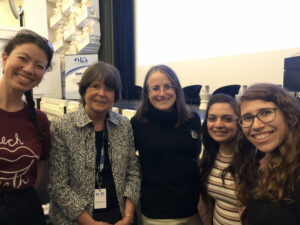
US reading/spelling guru Professor Linnea Ehri was recently here in Melbourne courtesy of Learning Difficulties Australia (the selfie at right proves we met her), and talked about this strategy, which she calls the “Spelling Pronunciation Strategy”. She says that in Connectionist theory, to put a word’s spelling into long-term memory, the letters must be connected to ‘phoneme mates’ in the pronunciations of the word.
To use the Spelling Pronunciation Strategy (AKA “Spelling Voice” in the program Sounds-Write) you separate and say each syllable with stress, and pronounce all the letters. Prof Ehri’s examples were “ex cell ent ”, “lis ten”, “choc o late”, and “Feb ru ary”. She cited two studies (Drake & Ehri, 1984 and Ocal & Ehri, 2017) showing that assigning spelling pronunciations enhanced memory for spellings, in 4th graders and college students.
So in summary, it’s not just harmless to say words in a slightly funny way to halp, sorry, help yourself remember their spellings. It’s officially evidence-based.
New 2 ways to spell vowels cards, including a free deck
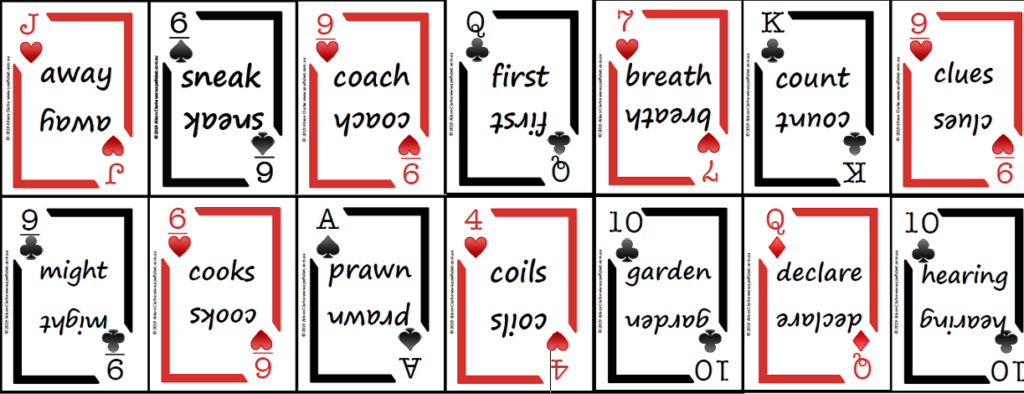
Some students need smaller-than-average steps and extra practice to get spelling patterns into long-term memory. Games are a great, nag-free way to get in lots of targeted, extra repetitions.
The newest set of download-and-print Spelfabet phonics playing cards has 14 decks, each with one vowel sound spelt two ways, and includes a free sample deck:
(more…)New decodable books for ‘o as in love’ and ‘a’ as in ‘ball’
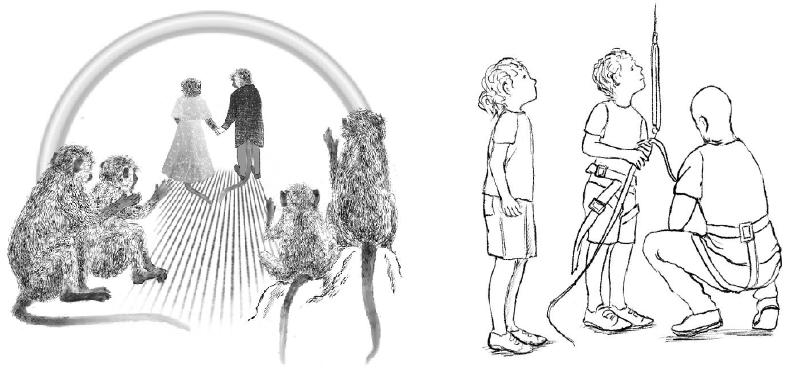
The spellings ‘o’ as in ‘love’ and ‘a’ as in ‘ball’ are in many words young children try to write. ‘One’, ‘love’, ‘some’, ‘once’, ‘all’, and ‘called’ are in the first 100 words on the Oxford Wordlist, ‘brother’, ‘other’, ‘come’, ‘water’, ‘also’, and ‘ball’, are in the 2nd 100, ‘won’ is number 206 and ‘small’ is number 228. *
However, these spelling patterns are often taught quite late in phonics teaching sequences. Many words containing these spellings are in early decodable book ‘tricky words’ lists.
Two new download-and-print Phonics With Feeling books allow children to practise words with these spellings, and notice the patterns in how they’re used: ‘love’, ‘dove’, ‘shove’, ‘glove’, ‘some’, ‘come’, ‘done’, ‘none’, ‘won’, ‘son’, ‘other’, ‘brother’, ‘mother’, ‘honey’, ‘money’ and ‘monkey, and ‘all’, ‘ball’, ‘call’, ‘fall’, ‘hall’, ‘mall’, ‘tall’, ‘wall’, ‘stall’, and ‘small’.
These new books expand the Extended Code Set 1 from three to five books. They otherwise contain only Initial Code spellings, plus the small number of ‘tricky words’ listed at the start of each book for pre-teaching. This means skilled teachers can slot them into phonics teaching sequences without introducing other, more difficult sound-spelling relationships.
The Monkeys’ Wedding
In Zulu, a sunshower is called umshado wezinkawu, meaning ‘monkey’s wedding’, so in some parts of Africa and the Caribbean, people say it’s a monkey’s wedding when the sun appears during rain. The new Phonics With Feeling Extended Code Set 1 book ‘The Monkeys’ Wedding’ is a cute, rhyming story of two monkeys in love whose wedding is almost spoilt by rain:
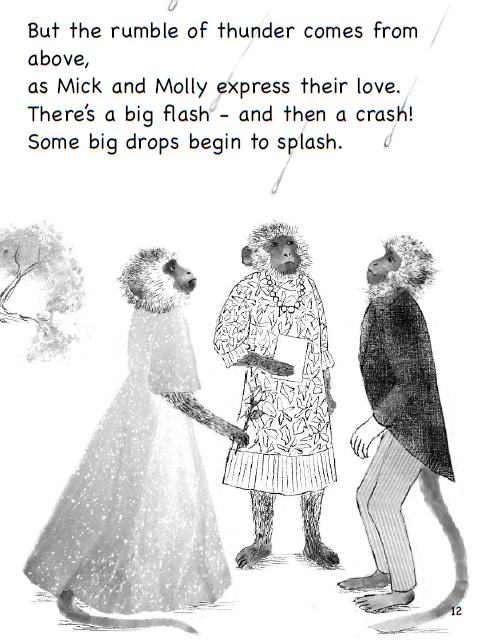
As well as giving children decoding and vowel-flexing practice, I love that this book offers an opportunity to discuss idioms, and that the idiom it refers to comes from a language and culture many English-speakers know little about.
Author and illustrator Gaia (AKA Teresa) Dovey has excelled herself with this book’s illustrations. The monkeys look fluffy enough to pat, and there are some gleefully naughty-looking little ones.
Up The Wall
The second new Extended Code Set 1 book, ‘Up The Wall’, also presents an opportunity to discuss literal and figurative meanings. It begins with a mother telling her children they’re driving her up the wall playing soccer in the hall, so they decide to go to the mall where there is a climbing wall. One child races to the top of the wall but then freezes, afraid he’ll fall. His mother must literally go up the wall to coax him, red-faced, back down. This series is not called Phonics With Feeling for nothing!

Free quizzes, and free upgrade if you have EC Set 1 already
Quizzes about these and all the other Phonics With Feeling books are available free on Wordwall, or you can download them here. Use them as is, or put some or all questions into Kahoots or other formats to suit your learners. There’s been a slight edit to the first Extended Code Set 1 book, Nancy Visits the City, which is reflected in its updated quiz, and a few other improvements across other books in the series.
Everyone who bought the original Extended Code Set 1 when it had only three books has been sent the new set of five books and updated quizzes via We Transfer. If that includes you, please download the files quickly, before the transfer expires, and let us know if you have difficulty.
Print up to 5 books @ 40c per copy, or up to 30 books @ 20c per copy
All the Phonics With Feeling books are available in either parent/aide sets (print up to 5 copies for 40c per print) or bulk teacher/clinician sets (print up to 30 copies for 20c per print). You provide the paper/card, printer and time printing and assembling them, so please factor these into your ‘is this good value?’ decision-making.
The Phonics With Feeling books aren’t for absolute beginners, as there are already plenty of good decodable books available for them. Some children will be able to read them towards the end of their first year of school, but they’re mostly for children in their second or third year of school, or slightly older catch-up learners.
More information about these books, including how to print and assemble them, can be found in this 2021 blog post. There is also an author interview here, and information about each book’s title, target spelling(s), number of words and plot in its entry in the Spelfabet shop. If you don’t already have the free sample book, it’s here.
* In the first 200 Oxford words containing a one-letter ‘o’ spelling, it is pronounced as in ‘got’ 15 times, as in ‘love’ 8 times, as in ‘so’ 7 times and as in ‘to’ 5 times.
Affordable basic phonics kit
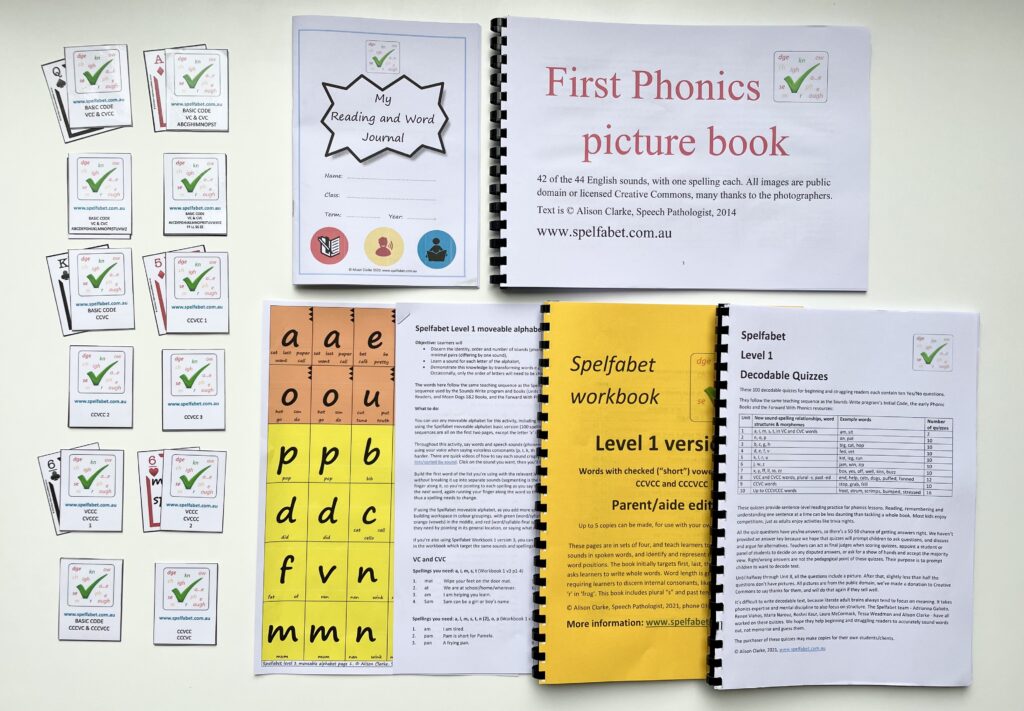
Thanks to the pandemic, many children seem to have done year or more of disrupted schooling without having learnt to read or spell much. A new batch of Australian five-year-olds start school soon, where many will (happily) be taught the systematic, explicit phonics that’s helpful for all, harmful for none and crucial for some*, but many won’t.
The download-and-print Spelfabet Level 1 kit aims to equip you to help beginners and strugglers of any age learn to read and spell one-syllable words with up to seven sounds. The kit follows this teaching sequence (the same as the Sounds-Write program):
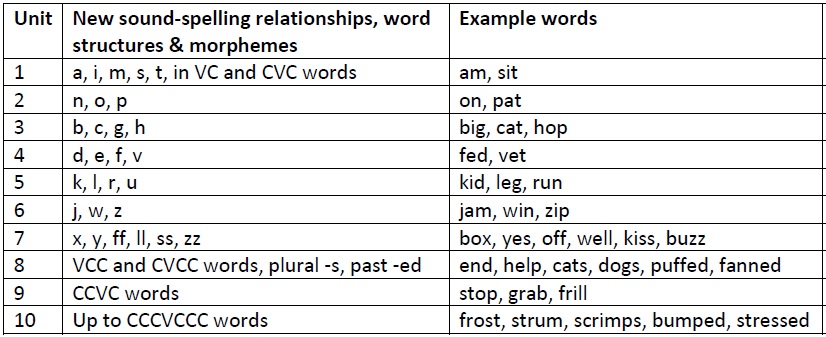
The kit contents are a workbook, quizzes, moveable alphabet, word-building sequences, playing cards, reading journal and phonics picture book. The only difference between the parent/aide kit and the teacher/clinician kit is how many copies of the workbook you may print (5 or 30 copies).
All the items in this kit are available separately from the Spelfabet website, except the simplified Moveable Alphabet, which contains only the spellings needed for Level 1. However, it’s cheaper to get the kit than each item separately ($55 including GST for the parent/aide version and $65 for the teacher/clinician one).
Decodable books for reading practice which follow the same teaching sequence include the Units 1-10 Sounds Write books including free e-books, the Units 1-10 Dandelion and Moon Dogs books from Phonic Books, and the printable Drop In Series Levels 1 and 2.
If this kit is too basic for your learner(s), more difficult kits will be available soon.
* See article by Catherine Snow and Connie Juel (2005) at https://psycnet.apa.org/record/2005-06969-026
New Phonics With Feeling books and author interview
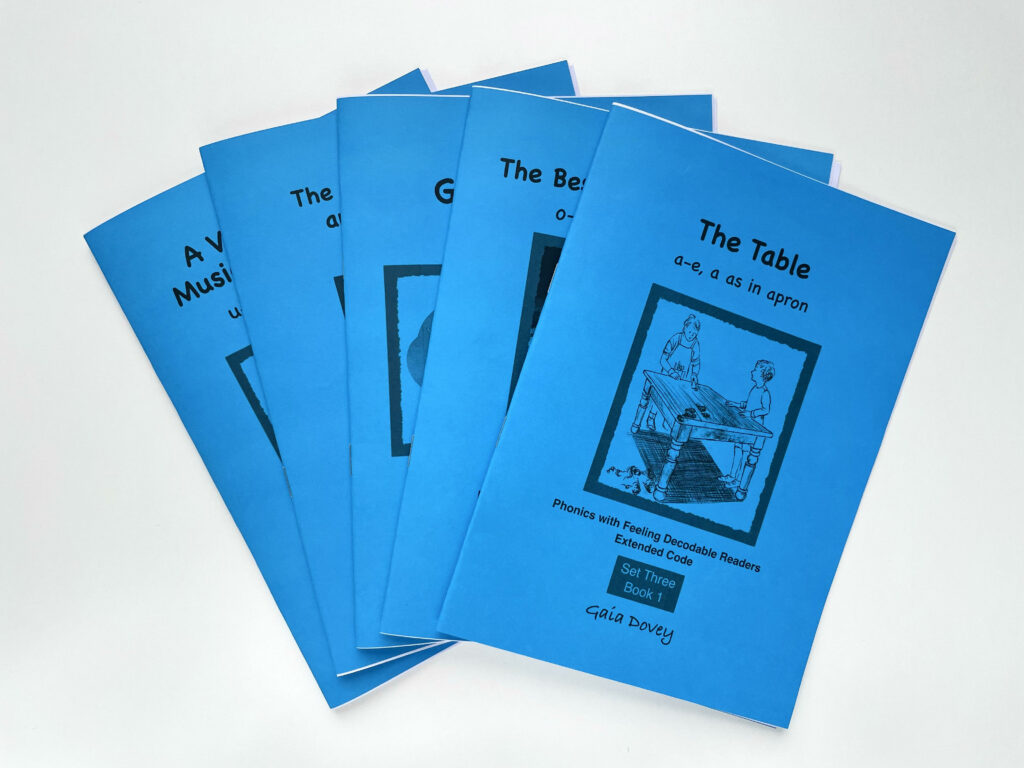
Set Three of the download-and-print Phonics With Feeling Extended Code readers are now available from the Spelfabet shop.
These books provide lots of reading practice of words with single-letter ‘long’ vowel sounds, as in ‘apron’, ‘being’, ‘final’, ‘open’ and ‘using’.
Many of these are suffixed forms of the ‘split vowel’/’silent final e’ spellings in Set Two e.g. make-making, Swede-Swedish, ice–icy, hope-hoped, cute-cutest. Word lists at the start of each book make this explicit.
The ‘c’ as in ‘ice’ and ‘g’ as in ‘age’ spellings, which often occur with these spellings, are practised in the Extended Code Set One books.
The Set Three books also include the ‘short’ vowel sounds, as in ‘at’, ‘red’, ‘in’, ‘on’ and ‘up’. When tackling new words, children should be encouraged to try both sounds for a vowel letter, if the first sound they try doesn’t produce a word that makes sense. This requires phoneme manipulation skills, and the knowledge that a spelling can represent more than one sound.
Like the other Phonics With Feeling books, the Set Three books have a print-5-copies version (parent/aide) for 40c per print, and a bulk print-30-copies version (teacher/clinician) for 20c per print. Our free quizzes (downloadable or on Wordwall) have been updated to include Set Three.
Teresa Dovey (pen name Gaia Dovey, as that’s what her grandkids call her) is the author of the Phonics With Feeling decodable readers. Here’s a 15-minute interview in which she discusses why she started writing the books, why they’re called Phonics With Feeling, her academic background in English Literature, what the books are like, who they’re for, how they can be used, and some of the feedback she’s received on them.
We hope these books make decodable text interesting and enjoyable for children, and affordable for adults, and that they help kids learn to decode as well as Teresa’s grandkids, so they can go on to enjoy reading whatever they choose.
If you’ve tried the books, please share any comments or feedback you have below.
